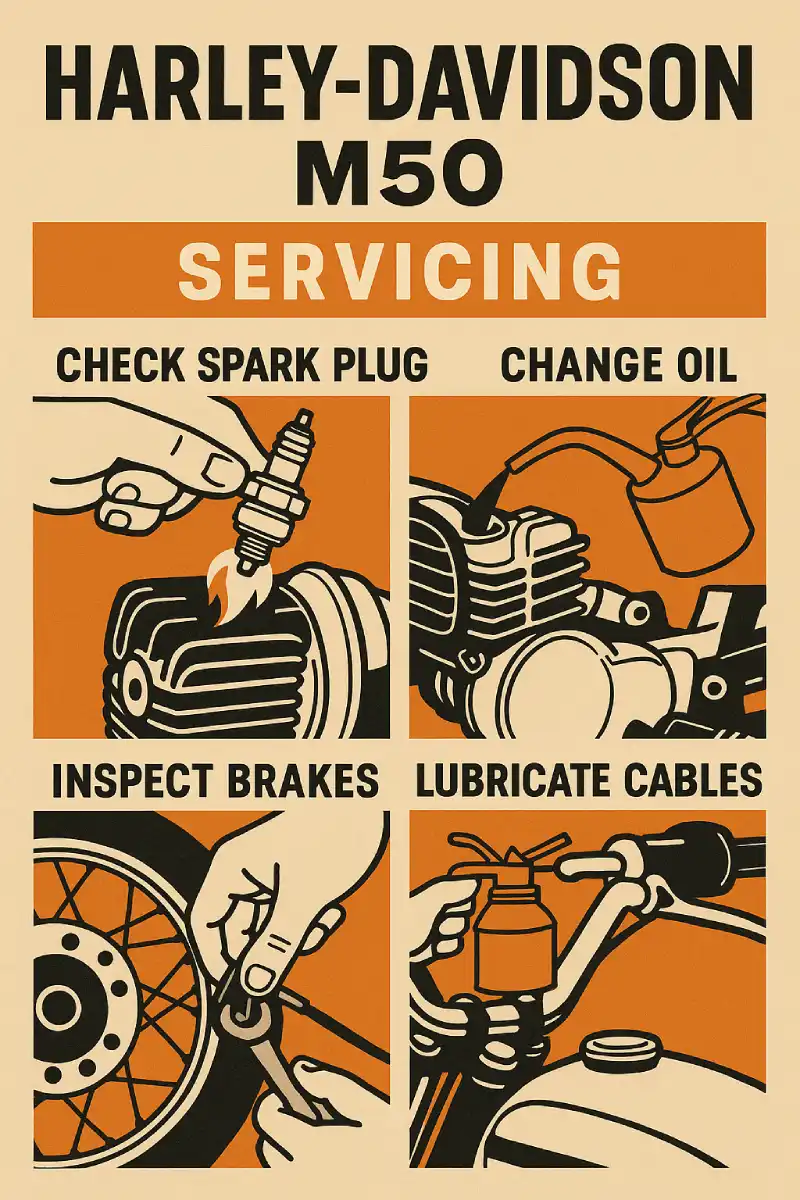- Posted on
- • History
Harley-Davidson M50: The Smallest Harley Ever Made
- Author
-
-

- User
- Torque
- Posts by this author
- Posts by this author
-
The Tiny Titan: Unraveling the Mystery of the Harley-Davidson M50
A Story from Subscriber of rd350.info!
Hey, friends! I'm an Italian motorcycle enthusiast and was born and raised in the hills of Tuscany, where the blend of engines and the perfume of olive trees are entwined. My garage is full of bikes, however, none have captured my heart like the Harley-Davidson M50. This little machine--a 50cc 2-stroke masterpiece--is the smallest Harley ever. The M50 was produced here in Italy by Aermacchi. It's a little Vespa with a Harley spirit and a piccolo gigante full of history. But why does this 50cc baby, born in the 1960s still make me drool and collectors weak at the knees? Let's take a spin down memory lane; from the boulevards of Florence to vintage shows of today, and let's find out why it is so speciale.
Why Did Harley-Davidson Build a 50cc Bike in Italy?
Imagine Italy in 1965: scooters and small motorcycles are everywhere, lateral-motion motorized vehicles buzzing through piazze and narrow medieval streets. Vespa and the Honda Super Cub were king... cheap fun rides for young people and people who lived in the city. Harley-Davidson, famous for its big, growling V-Twins, wanted a piece of this action. But they didn’t know small bikes, so they turned to Aermacchi, an Italian company they’d bought into. The result? The M50, launched in 1965 for just $225—a bargain compared to the Honda Trail 70’s $300+ (Road Dirt). It was made for beginners, teenagers, and anyone who wanted freedom on a budget. By 1966, production stopped, with only about 10,500 units made (Classic Motorbikes). Why so short-lived? Maybe it was too different for Harley’s tough-guy image, or maybe the market moved on. Whatever the reason, it’s now a rare treasure that collectors hunt like truffles.

Does the M50’s Italian Design Still Charm Riders?
Close your eyes and imagine a bike that looks like it belongs in a 1960s Italian movie, maybe ridden by a young Sophia Loren. The M50 is all about simplicity with a touch of bellezza. Its slender frame, spoked wheels, and bright red paint (sometimes blue) scream Italian flair. The small gas tank and long, narrow seat are pure Aermacchi, though some say the taillight, borrowed from bigger Harleys, looks a bit out of place ([Cycle World][invalid url, do not cite]). There’s no chrome overload here—just a Harley badge on the tank, proud and bold. It’s light, probably 150–170 pounds, and feels like a bicycle with an engine. Can this retro look still turn heads today? For those of us who love vintage bikes, it’s like a fine Chianti—simple, classic, and full of character.
What Powers This Tiny Harley? The M50’s Specs
Let’s pop the hood—or rather, peek at the engine. The M50’s heart is a 50cc single-cylinder 2-stroke, pumping out about 4–5 horsepower. It’s not going to race a Ducati, but it’s perfect for short trips. The 3-speed transmission uses a twist-grip shifter on the left handlebar, a quirky feature that makes you smile (Classic Motorbikes). Suspension is basic—telescopic forks up front, dual shocks in the back—and drum brakes handle stopping. Here’s the full picture:
| Specification | Details |
|---|---|
| Model | Harley-Davidson M-50S “Boy Racer” |
| Production Years | 1965–1966 |
| Engine Type | 50cc, single-cylinder, 2-stroke |
| Power | ~4–5 hp (estimated) |
| Transmission | 3-speed, handlebar-operated |
| Price (New in 1966) | $225 |
| Dry Weight | ~150–170 lbs (estimated) |
| Seat Height | ~28–30 inches (estimated) |
| Fuel Capacity | ~1.5–2 gallons (estimated) |
| Suspension | Front: Telescopic forks; Rear: Swingarm with dual shocks |
| Brakes | Drum brakes (front and rear) |
| Tires | 17-inch front and rear (assumed) |
Note: Some specs are estimates due to limited records.
This setup is all about ease, not power. Is it enough for today’s riders? If you’re after nostalgia, it’s more than enough.
How Does Riding the M50 Feel Like a Time Machine?
The experience of riding an M50 is akin to enjoying an espresso in a sunny piazza—it's uncomplicated, uncomplicated and very much enjoyable. The song of the 2-stroke engine has a delightful higher-pitched putt-putt—unlike the deep, rumble of the Harley cruisers. You twist the throttle and . . . whew! Off you go, light as a feather and very responsive. The M50 still handles busy Roman traffic well! Or peacefully gliding down the winery road, sunlight shining, fresh air blowing through your face. The twist-grip shifter takes a bit of getting used to...but once you figure it out, it's like you are dancing with the bike. The M50 is estimated to weigh 150-170 pounds, which is a great weight, as almost any rider can manage it, from beginner to advanced.
Who’s the M50 For? A Bike for Dreamers
Back in ’65, the M50 was for young Italians like my cousin Marco, who dreamed of owning a Harley but couldn’t afford a big one. It was perfect for teenagers, students, or anyone needing a cheap ride to work. Today, it’s a different story. With so few left, the M50 is a collector’s prize, selling for $1,120–$6,810 at auctions (Classic.com). If you love restoring old bikes or showing off at vintage meets, this is your bambino. It’s not for daily commuting—parts are too hard to find, and it’s not built for speed. But for those of us who see motorcycles as art, the M50 is a masterpiece. Who wouldn’t want to own a piece of Harley’s Italian adventure?
Can You Keep an M50 Running in 2025?
Owning an M50 is like caring for a classic Fiat 500—it takes amore and patience. The 2-stroke engine is simple but needs regular love, like mixing oil with fuel and checking the spark plug. Parts are rare, so you might need to hunt through old shops or connect with other collectors. I heard of one motociclista who rebuilt his M50’s engine in 2008, and it still runs like a charm (Road Dirt). With care, these bikes can still ride, but they’re better for short spins or display than daily use. It’s a commitment, but isn’t that what makes owning a vintage bike so rewarding? Can you keep its heart beating? With dedication, sì, certo.
Why Does the M50 Still Steal Hearts?
The M50 is not simply a motorcycle; it is a declaration of love to another time. For me, it is a reminder of the golden days of motorcycles in Italy, when motorcycles like Aermacchi and company were helping shape two-wheeled culture. It is Harley-Davidson's smallest bike, yet it has a great story - an audacious experiment to mesh American brashness with Italian panache. In the eyes of collectors, it is only a bike and therefore doesn't hold value as evidenced by its rarity but in the eyes of a rider like me, it has a soul. It is not about the horsepower, it is about the bliss of riding something different to everybody else.
Tips to Own and Love Your M50
Want to bring an M50 into your life? Here’s my advice, straight from the heart:
- Hunt with Care: These bikes are rare. Buy from trusted sellers or restorers to avoid fakes.
- Check the Details: Look for original Aermacchi parts, especially the engine and frame, to keep its value.
- Maintain with Love: Keep the 2-stroke engine happy with regular oil mixes and tune-ups.
- Find Your Tribe: Join vintage bike clubs in Italy or online to share tips and find parts.
- Ride for Joy: Use it for short rides or shows, not daily commutes. Let it shine at rallies.
Is the M50 worth it? If you dream of owning a piece of history, it’s assolutamente worth it.
Final Thoughts: Is the M50 Your Italian Dream Ride?
The Harley-Davidson M50 is a tiny spark in the brand’s big history, but oh, what a spark!A bike that combines Harley's boldness with the joy of Italy, the 50cc dream still has life. The M50 is for collectors searching for a rare piece of art or for riders who want a touch of the 1960s. Try to envision yourself zipping through a sunlit piazza, enjoying the hum of the engine mixed with laughter of your friends. Grab a helmet, embrace the dolce vita, and decide: is the M50 your kind of Harley? Buon viaggio, amici!
